Oral
New Strategies in RF Pulse Design
ISMRM & SMRT Annual Meeting • 15-20 May 2021

| Concurrent 1 | 16:00 - 18:00 | Moderators: Samy Abo Seada & Sydney Williams |
 |
0777.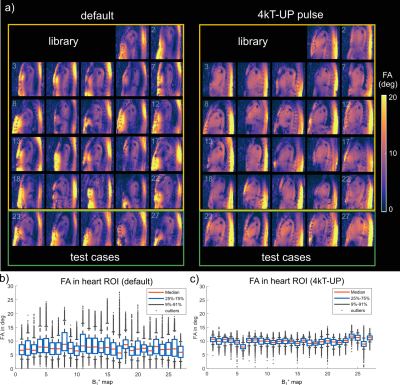 |
Calibration-free pTx of the human heart at 7T via 3D universal pulses
Christoph Stefan Aigner1, Sebastian Dietrich1, Tobias Schaeffter1,2, and Sebastian Schmitter1,3
1Physikalisch-Technische Bundesanstalt (PTB), Braunschweig and Berlin, Germany, 2Division of Imaging Sciences and Biomedical Engineering, King's College London, London, United Kingdom, 3Medical Physics in Radiology, German Cancer Research Center (DKFZ), Heidelberg, Germany
We demonstrate calibration free universal 4kT-points pulse design to achieve a subject independent, homogeneous flip-angle within the human heart at 7T. The proposed universal pulse was computed offline based on 22 three-dimensional B1+-maps of 20 volunteers with varying BMI and age (two of them were scanned twice with different coil placement). The optimized universal pulse was successfully applied experimentally to one volunteer from the library and four new unseen volunteers. In total we have analyzed 27 B1+ maps from 24 volunteers. Experimental data at 7T validate the B1+ predictions and demonstrate successful plug-and-play 3D pTx of the human heart.
|
|
0778.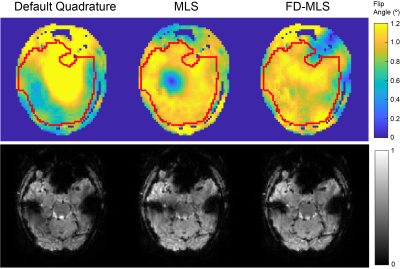 |
Robust RF Shimming and Small-tip-angle Multi-spoke Pulse Design with Finite Difference Regularization
Zhipeng Cao1, Adrian Paez2, Chunming Gu2, and Jun Hua2
1Vanderbilt University, Nashville, TN, United States, 2Johns Hopkins University, Baltimore, MD, United States
This study presents a finite difference regularized magnitude-least-squares algorithm that ensures robust RF shimming and small-tip-angle multi-spoke pulse design against excitation nulls and sub-optimal pulse solutions. It also calculates a monotonic trade-off between flip angle error and RF power. It was validated in simulations and experiments, and was effective for brain and knee imaging. During an EPI-based fMRI at 7T with dynamic RF shimming, the algorithm ensured high SNR throughout the human brain, compared to a near-complete local signal loss by the conventional magnitude-least-squares algorithm. Overall, the algorithm streamlines the workflow for patient-tailored 2D multislice imaging at UHF.
|
||
 |
0779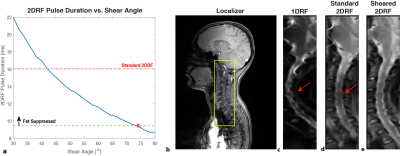 |
Off-resonance Robustness in Reduced FOV Imaging using Sheared 2DRF Excitation
Bahadir Alp Barlas1,2, Cagla Deniz Bahadir1,2,3, Ugur Yilmaz2, and Emine Ulku Saritas1,2,4
1Department of Electrical and Electronics Engineering, Bilkent University, Ankara, Turkey, 2National Magnetic Resonance Research Center (UMRAM), Bilkent University, Ankara, Turkey, 3Department of Biomedical Engineering, Cornell University, New York, NY, United States, 4Neuroscience Graduate Program, Bilkent University, Ankara, Turkey
The use of 2D echo-planar radiofrequency (2DRF) excitation has been widely applied in reduced field-of-view imaging of targeted regions, especially for diffusion weighted imaging (DWI). This work proposes effective and efficient coverage of the excitation k-space by shearing the 2DRF trajectory. This approach enables significant improvement in off-resonance robustness of 2DRF pulses by minimizing the pulse duration. It also promises improved clinical utility by increasing SNR in problem regions, eliminating slice coverage limitations and providing inherent fat suppression capability.
|
|
0780.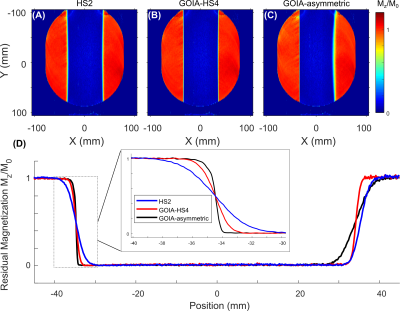 |
Asymmetric GOIA pulses for highly selective B1 and T1 independent outer volume suppression
Chathura Kumaragamage1, Peter B Brown1, Scott McIntyre1, Terence W Nixon1, Henk M De Feyter1, and Robin A de Graaf1
1Department of Radiology and Biomedical Imaging, Magnetic Resonance Research Center, Yale University, New Haven, CT, United States
An asymmetric GOIA pulse was developed (Tp = 6.66 ms, BW = 20 kHz) by combining two adiabatic half passage pulses (hyperbolic secant and hyperbolic tangent GOIA modulations). The pulse achieves an asymmetrical excitation/inversion profile, thus was used in a multi-pulse OVS sequence to achieve an efficient, highly-selective, B1 and T1-independent signal suppression with a transition width of only 1.7% of the bandwidth.
|
||
0781.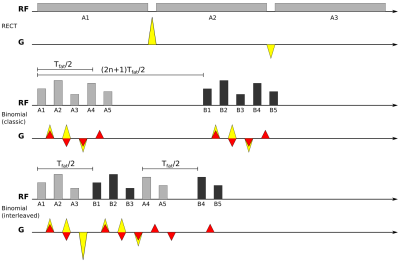 |
Interleaved Binomial kT-Points for Water-Selective Imaging at 7T
Daniel Löwen1, Eberhard Daniel Pracht1, Rüdiger Stirnberg1, and Tony Stöcker1,2
1German Center for Neurodegenerative Diseases (DZNE), Bonn, Germany, 2Department of Physics and Astronomy, University of Bonn, Bonn, Germany
Achieving homogeneous fat suppression is important for a wide range of MRI applications. In this work, we present time-efficient water-selective, parallel transmit RF excitation pulses for ultra-high field applications. This method combines the properties of kT-points with water-selective binomial pulses to achieve short, B1 insensitive water excitation pulses.
|
||
 |
0782.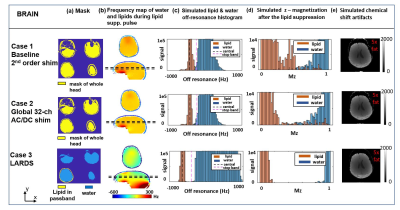 |
Lipid Artifact Removal by Dynamic Shimming (LARDS) with multi-coil B0 shim arrays
Jinmin Xu1,2, Nicolas Arango2, Congyu Liao2,3, Berkin Bilgic2,3, Zijing Zhang1,2, Lawrence L Wald2,3, Setsompop Kawin2,3, Huafeng Liu1, and Jason P Stockmann2,3
1State key Laboratory of Modern Optical Science and Engineering, Zhejiang University, Hangzhou, China, 2A. A. Martinos Center for Biomedical Imaging, Massachusetts General Hospital, Charlestown, MA, United States, 3Harvard Medical School, Boston, MA, United States
We show that a switched B0 offset field can be used to improve lipid suppression pulse performance in 2D imaging by pushing water and lipids apart in the frequency domain. The method is realized using multi-coil B0 shim arrays with rapidly switchable output currents that can be turned on during the lipid suppression pulse. Convex optimization is used to jointly solve for the shim currents and the lipid suppression pulse center frequency to optimize lipid suppression while minimize water signal loss. Applications to brain and body imaging are considered.
|
|
0783. |
Inner Volume Excitation via Joint Design of Time-varying Nonlinear Shim-array Fields and RF Pulse
Molin Zhang1, Nicolas Arango1, Jason Stockmann2, Jacob White1, and Elfar Adalsteinsson1,3,4
1Department of Electrical Engineering and Computer Science, Massachusetts Institute of Technology, Cambridge, MA, United States, 2Athinoula A. Martinos Center for Biomedical Imaging, Charlestown, MA, United States, 3Harvard-MIT Health Sciences and Technology, Massachusetts Institute of Technology, Cambridge, MA, United States, 4Institute for Medical Engineering and Science, Massachusetts Institute of Technology, Cambridge, MA, United States
Inner volume excitation is a promising technique to save scanning time or improve spatial resolution. Shim arrays provide nonlinear fields that extend the possibility of RF excitation of complicated spatial patterns. Yet previous work only employed static non-linear B field and predefined RF pulse which limits the performance. Validated on a fairly difficult tailored 3d volume pattern, jointly designed time-varying nonlinear B field and RF pulse within the auto-differentiable Bloch simulator framework shows substantial improvements. The accuracy improves 62% in terms of L2 norm with incorporated constraints on available RF pulse power.
|
||
 |
0784.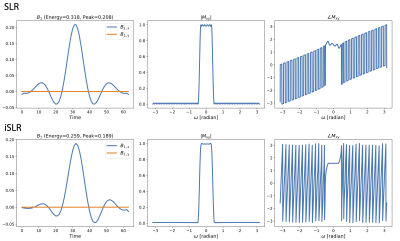 |
iSLR: An Improved Shinnar-Le-Roux Frequency Selective Pulse Design Algorithm with Reduced Energy and More Accurate Phase Profiles
Frank Ong1, Michael Lustig2, Shreyas Vasanawala1, and John Pauly1
1Stanford University, Stanford, CA, United States, 2University of California, Berkeley, Berkeley, CA, United States The Shinnar-Le-Roux (SLR) algorithm is widely used for designing frequency selective pulses with large flip angles. We improve its design process to generate pulses with lower energy (by as much as 26%) and more accurate phase profiles. Concretely, the SLR algorithm consists of designing two polynomials that represent Cayley-Klein (CK) parameters. Because the CK polynomial pair is bi-linearly coupled, the original algorithm sequentially solves for each polynomial. This results in sub-optimal pulses. Instead, we leverage a convex relaxation technique to jointly recover the CK polynomials. Our experiments show that the resulting pulses almost always attain the global solution in practice. |
|
0785.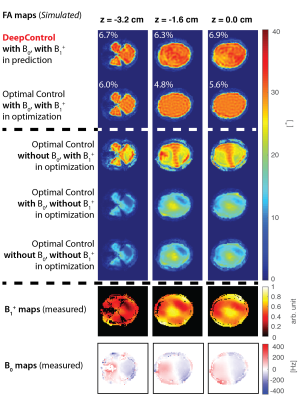 |
DeepControl: AI-powered slice flip-angle homogenization by 2DRF pulses
Mads Sloth Vinding1, Christoph Stefan Aigner2, Jason Stockmann3,4, Bastien Guérin3,4, Sebastian Schmitter2,5, and Torben Ellegaard Lund1
1Center of Functionally Integrative Neuroscience, Aarhus University, Aarhus, Denmark, 2Physikalisch-Technische Bundesanstalt (PTB), Braunschweig and Berlin, Germany, 3Harvard Medical School, Boston, MA, United States, 4Martinos Center for Biomedical Imaging, Massachusetts General Hospital, Charlestown, MA, United States, 5Center for Magnetic Resonance Research, University of Minnesota, Minneapolis, MN, United States
We test the DeepControl convolutional neural network for brain slice 2DRF 30o excitations (single-channel) at 7 T with a uniform FA profile. While the DeepControl framework was originally designed for localized 2D spatial-selective excitations, we demonstrate robustness towards FA homogenization at 7 T. Our numerical study, a comparison to gradient-ascent-pulse-engineering optimal control pulses, shows good pulse performance and (near-)conformity to the optimal control training library, including the RF pulse constraints. The DeepControl pulse prediction time takes only ~9 ms, which is more than 1000 times faster than the optimal control.
|
||
0786.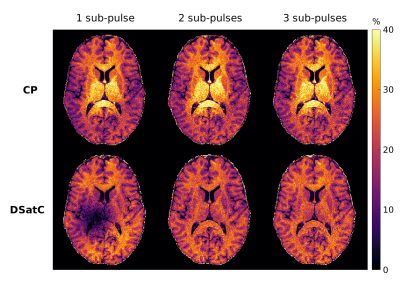 |
Uniform Magnetization Transfer contrast at 7T with Direct Saturation Control
David Leitão1, Raphael Tomi-Tricot2, Pip Bridgen1, Tom Wilkinson1, Patrick Liebig3, Rene Gumbrecht3, Dieter Ritter3, Sharon Giles1, Ana Baburamani1, Jan Sedlacik1, Joseph V. Hajnal1,4, and Shaihan J. Malik1,4
1Biomedical Engineering and Imaging Sciences, King's College London, London, United Kingdom, 2MR Research Collaborations, Siemens Healthcare Limited, Frimley, United Kingdom, 3Siemens Healthcare GmbH, Erlangen, Germany, 4Centre for the Developing Brain, King's College London, London, United Kingdom
Conventional RF pulse design methods optimize for rotation of the magnetization. However, in systems with Magnetization Transfer (MT) with a semisolid pool, the dynamics do not follow the Bloch equations; saturation of the semisolid depends on |B1+|2, making it particularly sensitive to B1+ inhomogeneities. This work employs a novel pulse design framework termed ‘Direct Saturation Control’ (DSatC) to directly consider semisolid saturation. We use this to design composite pulses with spatially uniform semisolid saturation using parallel transmition at 7T, where B1+ is intrinsically highly inhomogeneous. In-vivo results show much more homogeneous MT contrast when using DSatC.
|
The International Society for Magnetic Resonance in Medicine is accredited by the Accreditation Council for Continuing Medical Education to provide continuing medical education for physicians.